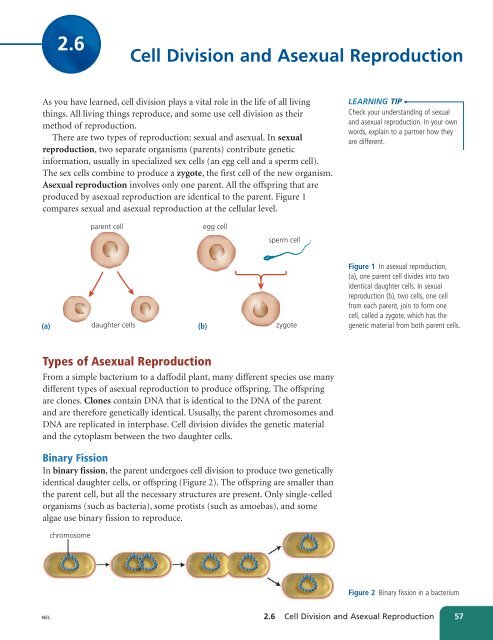Unit A Reproduction
Unit A Reproduction
Unit A Reproduction
Create successful ePaper yourself
Turn your PDF publications into a flip-book with our unique Google optimized e-Paper software.
2.6<br />
Cell Division and Asexual <strong>Reproduction</strong><br />
As you have learned, cell division plays a vital role in the life of all living<br />
things. All living things reproduce, and some use cell division as their<br />
method of reproduction.<br />
There are two types of reproduction: sexual and asexual. In sexual<br />
reproduction, two separate organisms (parents) contribute genetic<br />
information, usually in specialized sex cells (an egg cell and a sperm cell).<br />
The sex cells combine to produce a zygote, the first cell of the new organism.<br />
Asexual reproduction involves only one parent. All the offspring that are<br />
produced by asexual reproduction are identical to the parent. Figure 1<br />
compares sexual and asexual reproduction at the cellular level.<br />
LEARNING TIP<br />
Check your understanding of sexual<br />
and asexual reproduction. In your own<br />
words, explain to a partner how they<br />
are different.<br />
parent cell<br />
egg cell<br />
sperm cell<br />
(a)<br />
daughter cells<br />
(b)<br />
zygote<br />
Figure 1 In asexual reproduction,<br />
(a), one parent cell divides into two<br />
identical daughter cells. In sexual<br />
reproduction (b), two cells, one cell<br />
from each parent, join to form one<br />
cell, called a zygote, which has the<br />
genetic material from both parent cells.<br />
Types of Asexual <strong>Reproduction</strong><br />
From a simple bacterium to a daffodil plant, many different species use many<br />
different types of asexual reproduction to produce offspring. The offspring<br />
are clones. Clones contain DNA that is identical to the DNA of the parent<br />
and are therefore genetically identical. Ususally, the parent chromosomes and<br />
DNA are replicated in interphase. Cell division divides the genetic material<br />
and the cytoplasm between the two daughter cells.<br />
Binary Fission<br />
In binary fission, the parent undergoes cell division to produce two genetically<br />
identical daughter cells, or offspring (Figure 2). The offspring are smaller than<br />
the parent cell, but all the necessary structures are present. Only single-celled<br />
organisms (such as bacteria), some protists (such as amoebas), and some<br />
algae use binary fission to reproduce.<br />
chromosome<br />
Figure 2 Binary fission in a bacterium<br />
NEL<br />
2.6 Cell Division and Asexual <strong>Reproduction</strong> 57

















